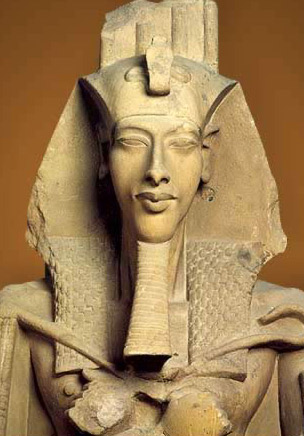 Amarna
Amarna  Amarna
Amarna
Age of Akhenaton
| Amarna | Saqqara | Abydos | Deir el-Medina | Resources | Index |
|---|
It was during the 18th Dynasty that Egypt was revolutionized because of one unconventional pharaoh, Akhenaton. His eccentric ideas changed the course of history as we know it. Art, culture, even Egypt’s religion was altered according to his will. This eventually led to the relocation of Egypt’s capital; and what began would eventually be known as the Amarna Period.
Art began to take on a new form. Hundreds of years ahead of its time, before the Greeks, art during the Amarna period began to look more modern. It looked more fluid, round, and less stoic than previous Egyptian sculpture. In a sense, it had a more realistic feel to it such as Classical Greek art. 
Until Akhenaton, Egypt was a polytheistic society; they believed in multiple gods. During the reign of Akhenaton, he amended the religion to be monotheistic, or the belief in one god: Aten. The strange aspect of this was, only Akhenaton and his wife, Queen Nefertiti could worship Aten directly. All others had to pray and worship the pharaoh.
Shortly after coming into power, Akhenaton expressed his desire to reconstruct a city of his own; but not just any city…a new capital. He relocated the capital of Egypt from Thebes to Amarna. Anxiously wanting his new city to be built, he and several architects devised a plan to construct the capital using small bricks, unlike the usual fashion being one ton blocks and large stones. Thus, Amarna was built within a matter of a couple of years.
However, this was a short-lived vision. Soon after Akhenaton’s death, his image was defaced from almost every monument and wall. Amarna was abandoned and Egypt returned to its old capital.